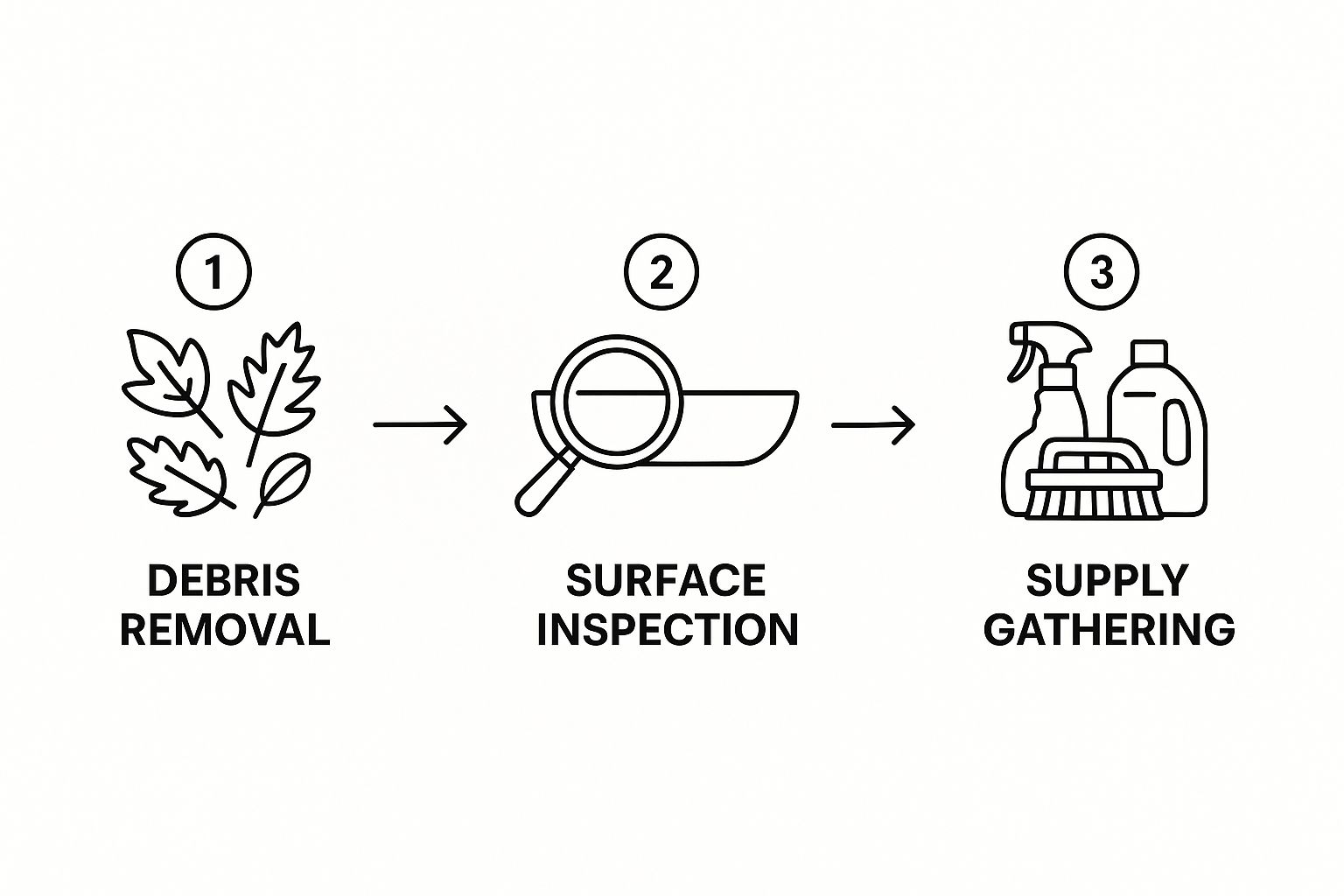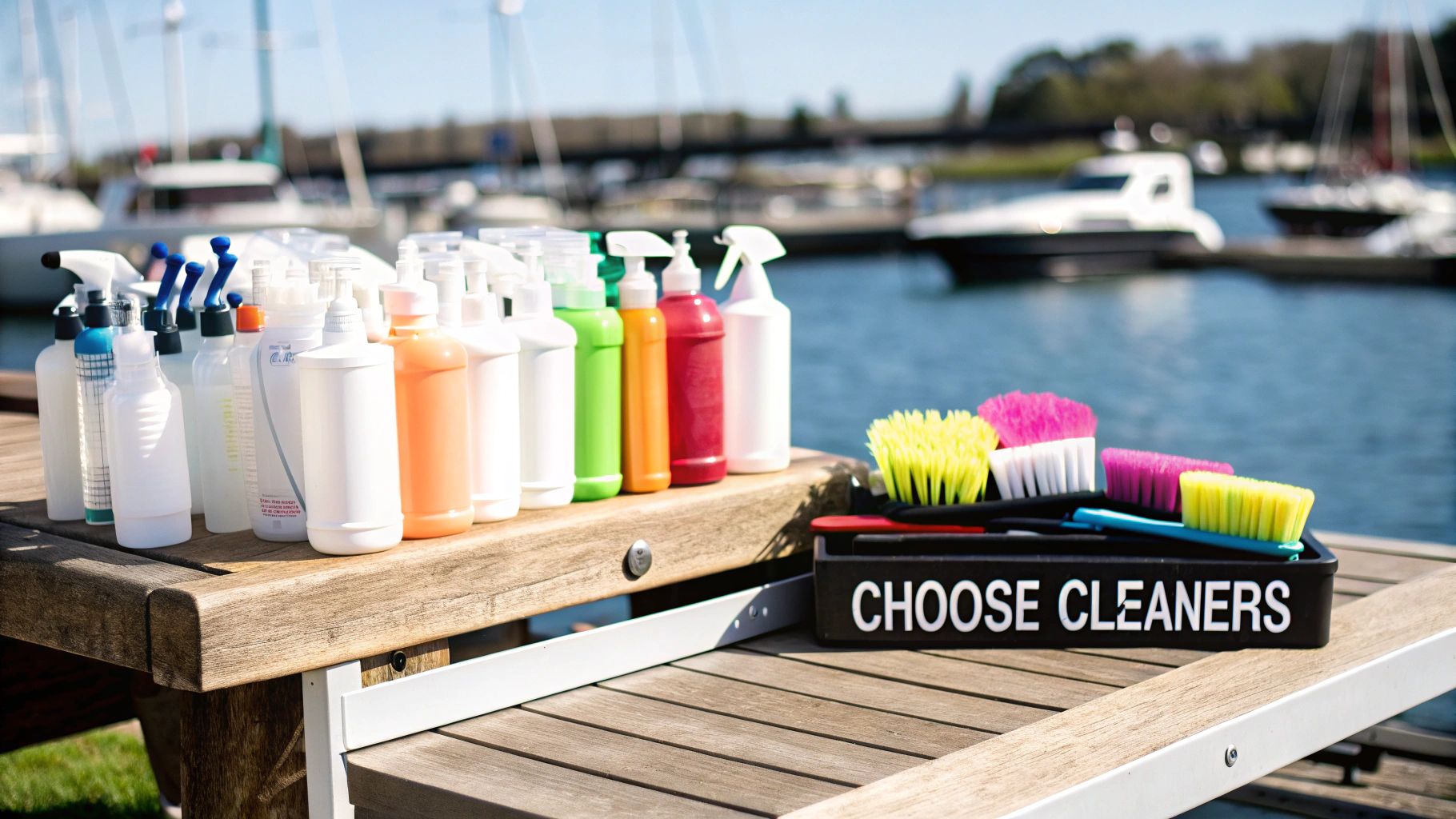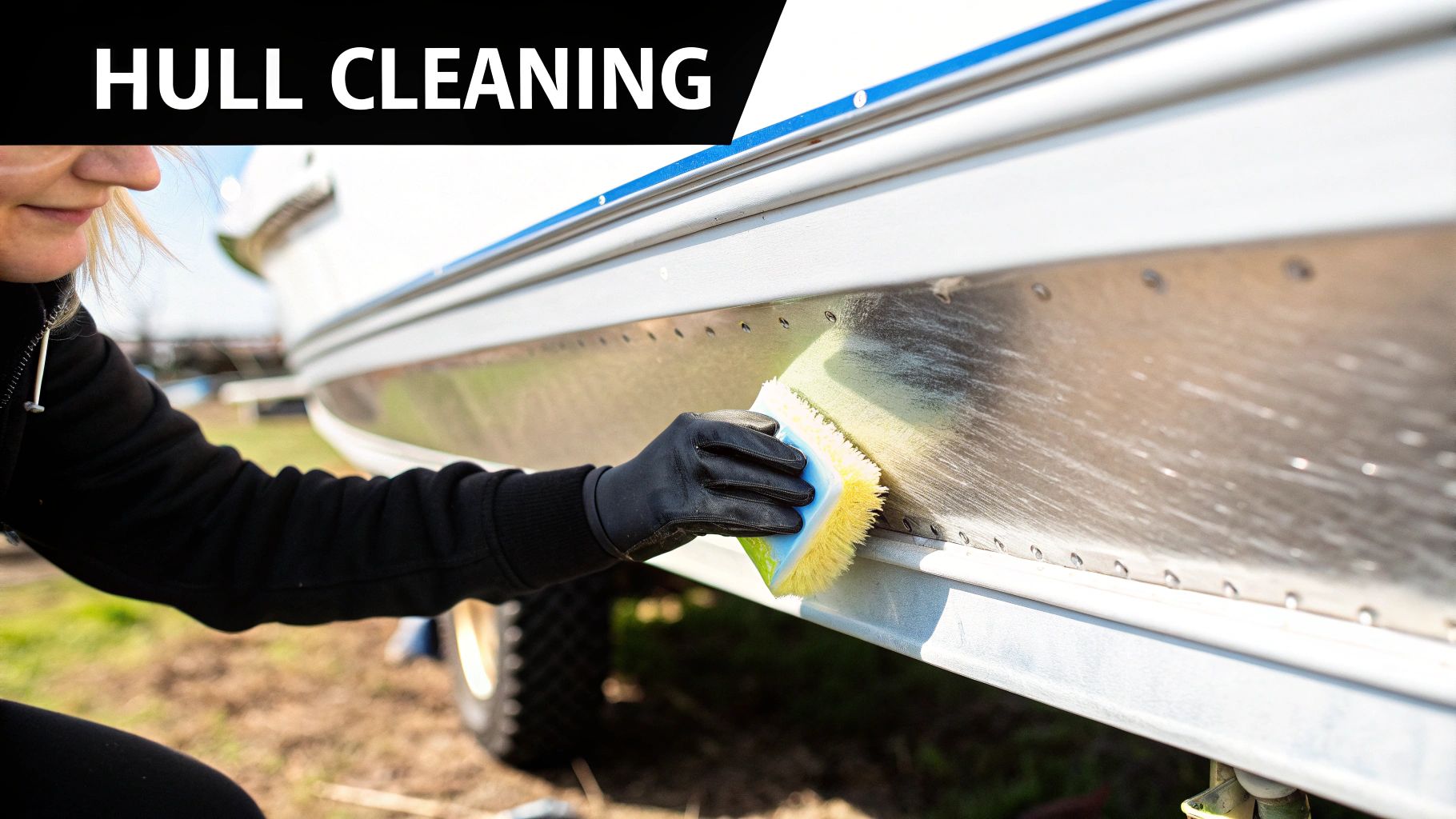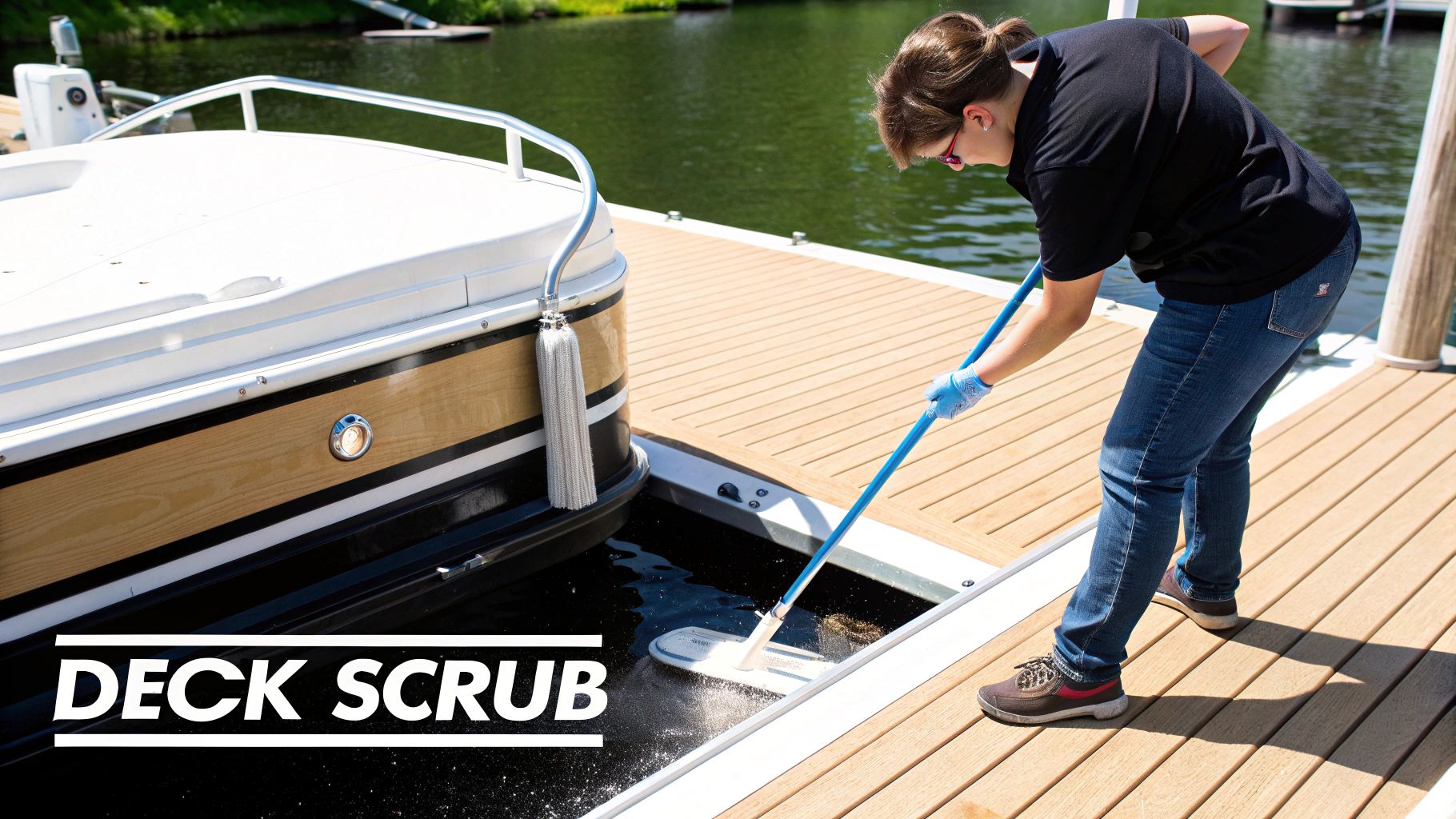How to Clean a Pontoon Boat: Expert Tips & Guide
Knowing how to properly clean a pontoon boat starts with a simple game plan. Before you even think about getting anything wet, take a few minutes to gather your supplies and give the boat a once-over. Trust me, this little bit of prep work is the secret to getting a professional-level clean without burning your entire Saturday scrubbing away.
Your Pontoon Cleaning Game Plan and Checklist
A great cleaning day is all about working smart, not hard. A little organization upfront saves you from constantly running back to the garage for a tool you forgot, helps you tackle the job in a logical order, and makes sure you don't miss a single spot. Think of it as your pre-flight check before you get to the satisfying part—making your boat shine.
This simple workflow shows how I approach the prep phase before the real cleaning begins.

The key takeaway here is to clear everything out, inspect for issues, and then gather your supplies. This stops you from just pushing dirt around from one spot to another.
Assembling Your Cleaning Toolkit
Having the right tools on hand makes all the difference in the world. You don’t need a professional-grade arsenal, just a few key items that are actually designed for marine use. I’ve seen people do more harm than good by using the wrong tool, like a stiff-bristle brush that scratches up beautiful vinyl seats.
Before starting any cleaning job, it's a good idea to lay out your tools. This quick reference table shows what I always have ready to go.
| Essential Pontoon Cleaning Supplies | ||
|---|---|---|
| Item | Purpose | Pro Tip |
| A Soft-Bristle Deck Brush | Gently scrubbing flooring and non-skid surfaces without scratching. | Get one with an extendable handle to save your back. |
| Multiple Microfiber Towels | Drying surfaces like windscreens and consoles without leaving lint behind. | Always use a clean, dry towel for the final wipe-down to avoid streaks. |
| Two Buckets | One for soapy water, one for clean rinse water. | This is a non-negotiable. Using a single bucket just puts dirty water back on the boat. |
Having these items ready ensures you can work efficiently without having to stop and search for something mid-scrub.
Why Consistent Cleaning Matters
Honestly, getting into a regular cleaning routine is the single best thing you can do for your boat’s longevity and appearance. This is especially true if you're boating in saltwater—it's absolutely non-negotiable. Salt residue is incredibly corrosive and will permanently dull the finish on your aluminum pontoons if you let it sit.
I’ve heard industry experts say that a simple freshwater rinse after each trip can prevent up to 80% of surface damage from salt, grime, and algae. That small habit pays huge dividends in protecting your investment. You can learn more about these best practices over at DiscoverBoating.com.
This isn't just about making your boat look pretty. It's about preventative care. By consistently washing away all those contaminants, you stop them from causing long-term, expensive damage that requires a whole lot more effort to fix later on.
Making Your Aluminum Pontoons Shine Again

The aluminum pontoons are the unsung heroes of your boat. They take a constant beating from algae, scum, and those stubborn waterline stains. Getting them to shine again isn't just about making your boat look good at the dock; it’s about fighting off corrosive gunk that can cause real damage over time.
First, take a good look at what you’re dealing with. Is it a light film of lake grime, or are you facing the dull, chalky mess of heavy oxidation? For the simple stuff, a quality boat soap is often all you need. But for the serious buildup, you'll have to bring out the big guns: a dedicated aluminum cleaner.
Choosing the Right Cleaner
The right approach here really depends on how tough the job is. If your pontoons haven't seen a good cleaning in a season or two, a multi-step process will give you the best results.
- For General Grime: A bottle of Better Boat's Boat Soap is a great starting point. It’s formulated to cut through dirt without stripping away any protective finishes you might have.
- For Tough Stains & Oxidation: This is where an Aluminum Cleaner becomes your best friend. These are typically acidic formulas that work chemically, dissolving the stains and oxidation that elbow grease alone can't touch. Just be sure to wear gloves and eye protection—this stuff is potent.
When you're applying an aluminum cleaner or brightener, technique is everything if you want to avoid a splotchy, uneven mess. I've learned to work in small, manageable sections, about three to four feet at a time. This keeps the cleaner from drying out before I can get it properly rinsed off.
Pro Tip: Always apply aluminum cleaners from the bottom up, but rinse them from the top down. This little trick prevents the cleaner from creating clean streaks as it runs down the tube, which can stain the uncleaned areas below. It makes a huge difference for a uniform finish.
Getting the Job Done Right
After applying the cleaner, grab a medium-stiff brush and give the surface a good scrub. You'll want to put some extra effort into that waterline, as that's where stains are usually the most baked-on. Don't forget the nooks and crannies around welds and mounting brackets; a small detail brush is perfect for digging grime out of those hard-to-reach spots.
Once you've scrubbed a section, rinse it thoroughly with fresh water before you even think about moving on. This methodical, section-by-section approach is the key to cleaning your pontoon's aluminum tubes without losing your mind.
It's a habit many dedicated boaters share. In fact, one study found that 83% of boat owners clean their vessels before transporting them over land, using everything from simple brushing to high-pressure spraying. These are the kinds of routines that keep a boat in top shape.
If your boat has fiberglass components, remember that they need a different kind of care. For that, you can check out our guide on how to clean a fiberglass boat for specific advice.
Finally, after your pontoons are sparkling clean and completely dry, finish the job with an aluminum polish or protectant. This final step creates a barrier against future oxidation and makes your next cleaning day a whole lot easier.
Bringing Your Decking and Flooring Back to Life

From muddy footprints after a trip to the sandbar to the inevitable spilled drink, your pontoon's flooring takes a beating. It bears the brunt of every fun day on the water, and keeping the deck clean is absolutely essential to the overall look and feel of your boat.
The right approach, however, depends entirely on what you’re standing on.
Marine-grade carpeting and vinyl flooring are the two most common options you'll find, and each requires a slightly different technique. The goal is always the same, though: lift away stains and ground-in dirt without resorting to harsh chemicals that could cause fading, brittleness, or long-term damage. This is a huge part of learning how to clean a pontoon boat the right way.
Tackling Marine Carpeting
If you have carpet, your first move is always to sweep or vacuum up all the loose debris. Think sand, dirt, and those stray potato chips from last weekend. Getting the dry stuff out first prevents you from turning it all into mud once you add water.
Next, grab a bucket and mix up a solution of Better Boat's Boat Soap with water. Liberally apply the soapy water to the carpet and just let it sit for a few minutes. You want to give it time to really penetrate the fibers and start loosening up all that grime. Then, take a medium-bristle brush and scrub the entire surface, working in small, overlapping sections to make sure you don't miss a spot.
The real secret to clean carpet is a thorough rinse. I can't stress this enough. Any soap you leave behind will just attract dirt like a magnet. Rinse until the water runs completely clear. If you have a shop vac, use it to pull out the excess moisture—it speeds up the drying time significantly.
Restoring Vinyl Flooring
Vinyl flooring is generally a bit easier to clean, but it's notorious for scuff marks and picking up mildew in damp corners. Just like with carpeting, start with a good sweeping to get rid of any loose dirt.
For your routine clean-up, the same boat soap solution works perfectly. But for tougher scuffs or stubborn stains that just won't budge, a dedicated Deck Cleaner is going to be your best friend.
- Spray the cleaner directly onto the affected areas.
- Agitate with a soft brush to lift the stain. You want to be firm but gentle enough that you don't scratch the vinyl.
- Wipe it clean with a microfiber cloth and then give the entire deck a good, thorough rinse.
A clean deck is really the heart of your pontoon. It’s where all the action happens, so keeping it in great shape ensures it's always ready for your next adventure. Taking these simple steps protects your investment and keeps your boat looking sharp for years to come.
Reviving Your Vinyl Seats and Upholstery

Let's be honest, nothing kills the vibe of a clean boat faster than grimy, mildew-stained seats. Your upholstery takes a constant beating from moisture, sun, and greasy sunscreen, creating the perfect recipe for stains and premature aging. Getting them clean again isn't just about looks; it's about preserving the vinyl so it stays soft and tear-free for many seasons to come.
I see so many boat owners make the same mistake: they grab harsh household cleaners. A magic eraser might seem like a genius shortcut, but it's basically a super-fine sandpaper that grinds away the vinyl's protective top coat. Don't even get me started on bleach. It’s a death sentence for your upholstery, weakening the stitching and making the vinyl brittle until it cracks.
The Right Way to Clean Vinyl
To do this job safely and effectively, you need a cleaner designed specifically for marine-grade vinyl. For that everyday grime and those stubborn sunscreen smudges, grab a bottle of Better Boat's Vinyl Cleaner and spray it directly and generously onto the seats.
Give it a minute or two to work its magic and break down the grime. Then, take a soft-bristled brush or a microfiber towel and gently scrub in a circular motion. You’ll be surprised how quickly the dirt starts to lift right off.
Pro-Tip: For those nasty, set-in mildew spots, spray the cleaner on and then lay a damp towel over the area for about 10-15 minutes. This little trick keeps the cleaner activated and lets it penetrate deep into the stain, breaking down the mildew before you even start scrubbing.
Once you've scrubbed everything down, a thorough rinse with fresh, clean water is critical. Any leftover cleaner will become a sticky magnet for new dirt. Finish up by wiping everything with a dry microfiber towel to prevent water spots and get the surface ready for the final, most important step.
Protecting Your Clean Seats
You didn't do all that work for nothing. Applying a quality UV protectant spray is the final touch that creates a shield against the sun's damaging rays, which are the main cause of fading and cracking. Seriously, don't skip this. It's the key to making your next cleanup a whole lot easier.
If you want to dive deeper, you can check out these three easy ways to clean vinyl seats on your boat.
Perfecting the Details on Your Helm and Console
The real difference between a clean boat and one that looks truly detailed comes down to the final touches. After you've wrestled with the big surfaces like the pontoons and decking, it's time to zero in on the high-traffic, high-touch areas: your helm and console.
This is where you bring back that crystal clarity to gauges and windscreens, making every part you interact with feel brand new. I always start with a handheld vacuum or a soft brush to get the loose dust and debris out of all the little nooks and crannies. Pay special attention to cup holders and storage compartments where dirt loves to hide.
For a deeper clean on the hard surfaces, a damp microfiber towel with a little of our All-Purpose Cleaner works wonders.
Safely Cleaning Electronics and Screens
The most delicate part of this job is definitely cleaning your electronic screens and acrylic windscreen without leaving scratches or causing damage. Never spray cleaner directly onto a screen. Trust me on this one. You don't want liquid seeping into your expensive electronics.
Instead, lightly mist a clean microfiber cloth and gently wipe the screens and gauges to lift away smudges and dust. For the windscreen, you absolutely must use an ammonia-free plastic or acrylic cleaner. Using the wrong product here can cause clouding and even cracking over time, which is a costly mistake to fix.
It's also critical to be mindful of what cleaners end up in the water. Some products sold as "green" can be seriously misleading. Research from the BoatUS Foundation found that certain spot-treatment cleaners were hundreds of times more toxic to aquatic life than general boat soaps. It’s worth taking a moment to read their full findings on boat cleaning products to make informed choices.
Finally, don't overlook the bimini top hardware. A quick wipe-down of the metal poles and fittings removes water spots and salt residue. These small actions really complete the look and give your pontoon that polished, well-cared-for appearance every boater strives for.
Common Questions About Pontoon Boat Cleaning
Even with the best game plan, a few questions always seem to pop up in the middle of a big cleaning job. Let's run through some of the most common ones I hear from other pontoon owners. Nailing these down will help you perfect your cleaning process and tackle any curveballs your boat throws at you.
One of the first things people ask is how often they really need to clean their pontoon. The gold standard, especially if you're in saltwater, is a quick freshwater rinse after every single trip. A full-on deep clean, like the one we just walked through, should happen a few times a season and is non-negotiable before winter storage.
Using Pressure Washers and Handling Mildew
I get this question all the time: "Can I just use my pressure washer?" My answer is always the same: proceed with extreme caution. A pressure washer can be a great tool for bare aluminum tubes—if you use a wide fan tip and keep your distance—but it can be an absolute wrecking ball everywhere else.
That high-pressure stream will shred vinyl upholstery, tear up your carpet, and blast decals right off the fence. For most of the boat, a simple garden hose with a decent spray nozzle is the safer, and frankly, smarter choice.
When you're staring down ugly mildew on your seats, your best bet is a dedicated marine vinyl cleaner. You need something specifically made to kill mildew without relying on harsh chemicals. Whatever you do, avoid bleach. It’ll eat away at the stitching and dry out the vinyl, leading to nasty cracks down the road. Just apply the cleaner, give it a gentle scrub with a soft brush, let it work its magic for a few minutes, and then rinse it completely.
To keep that mildew from coming back, make sure you wipe the seats dry after using the boat and ensure your cover is well-ventilated so moisture can escape. Great boat care is as much about prevention as it is about cleaning. To dive deeper, check out the dos and don'ts of boat cleaning to steer clear of common mistakes.
At Better Boat, we have all the premium, easy-to-use products you need to protect your investment and keep your pontoon looking sharp. Explore our full range of cleaning supplies and get set for a season of worry-free boating.




